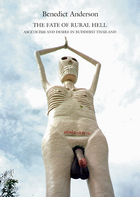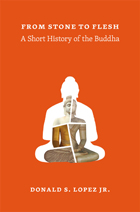133 books about Buddhism and 5
start with F
133 books about Buddhism and 5
133 books about Buddhism
5 start with F start with F
5 start with F start with F

The Fate of Rural Hell
Asceticism and Desire in Buddhist Thailand
Benedict Anderson
Seagull Books, 2012
In 1975, when political scientist Benedict Anderson reached Wat Phai Rong Wua, a massive temple complex in rural Thailand conceived by Buddhist monk Luang Phor Khom, he felt he had wandered into a demented Disneyland. One of the world’s most bizarre tourist attractions, Wat Phai Rong Wua was designed as a cautionary museum of sorts; its gruesome statues depict violent and torturous scenes that showcase what hell may be like. Over the next few decades, Anderson, who is best known for his work, Imagined Communities, found himself transfixed by this unusual amalgamation of objects, returning several times to see attractions like the largest metal-cast Buddha figure in the world and the Palace of a Hundred Spires. The concrete statuaries and perverse art in Luang Phor’s personal museum of hell included, “side by side, an upright human skeleton in a glass cabinet and a life-size replica of Michelangelo’s gigantic nude David, wearing fashionable red underpants from the top of which poked part of a swollen, un-Florentine penis,” alongside dozens of statues of evildoers being ferociously punished in their afterlife.
In The Fate of Rural Hell, Anderson unravels the intrigue of this strange setting, endeavoring to discover what compels so many Thai visitors to travel to this popular spectacle and what order, if any, inspired its creation. At the same time, he notes in Wat Phai Rong Wua the unexpected effects of the gradual advance of capitalism into the far reaches of rural Asia.
Both a one-of-a-kind travelogue and a penetrating look at the community that sustains it, The Fate of Rural Hell is sure to intrigue and inspire conversation as much as Wat Phai Rong Wua itself.
[more]

The Feast of the Sorcerer
Practices of Consciousness and Power
Bruce Kapferer
University of Chicago Press, 1997
Sorcery has long been associated with the "dark side" of human development. Along with magic and witchcraft, it is assumed to be irrational and antithetical to modern thought. But in The Feast of the Sorcerer, Bruce Kapferer argues that sorcery practices reveal critical insights into how consciousness is formed and how human beings constitute their social and political realities.
Kapferer focuses on sorcery among Sinhalese Buddhists in Sri Lanka to explore how the art of sorcery is in fact deeply connected to social practices and lived experiences such as birth, death, sickness, and war. He describes in great detail the central ritual of exorcism, a study which opens up new avenues of thought that challenge anthropological approaches to such topics as the psychological forces of emotion and the dynamics of power. Overcoming both "orientalist" bias and postmodern permissiveness, Kapferer compellingly reframes sorcery as a pragmatic, conscious practice which, through its dynamic of destruction and creation, makes it possible for humans to reconstruct repeatedly their relation to the world.
Kapferer focuses on sorcery among Sinhalese Buddhists in Sri Lanka to explore how the art of sorcery is in fact deeply connected to social practices and lived experiences such as birth, death, sickness, and war. He describes in great detail the central ritual of exorcism, a study which opens up new avenues of thought that challenge anthropological approaches to such topics as the psychological forces of emotion and the dynamics of power. Overcoming both "orientalist" bias and postmodern permissiveness, Kapferer compellingly reframes sorcery as a pragmatic, conscious practice which, through its dynamic of destruction and creation, makes it possible for humans to reconstruct repeatedly their relation to the world.
[more]

Folk Buddhist Religion
Dissenting Sects in Late Traditional China
Daniel L. Overmyer
Harvard University Press, 1976

The Foundation for Yoga Practitioners
The Buddhist Yogācārabhūmi Treatise and Its Adaptation in India, East Asia, and Tibet
Ulrich Timme Kragh
Harvard University Press
The Yogacarabhumi, a fourth-century Sanskrit treatise, is the largest Indian text on Buddhist meditation. Its enormous scope exhaustively encompasses all yoga instructions on the disciplines and contemplative exercises of sravaka, pratyekabuddha, and bodhisattva practitioners. The thoroughness of the text meant that the Yogacarabhumi became the fundamental source for later Buddhist writings on meditation across Asia. The present edited volume, conceived by Geumgang University in South Korea, brings together the scholarship of thirty-four leading Buddhist specialists on the Yogacarabhumi from across the globe. The essays elaborate the background and environment in which the Yogacarabhumi was composed and redacted, provide a detailed summary of the work, raise fundamental and critical issues about the text, and reveal its reception history in India, China, and Tibet. The volume also provides a thorough survey of contemporary Western and Asian scholarship on the Yogacarabhumi in particular and the Yogacara tradition more broadly. The Foundation for Yoga Practitioners aims not only to tie together the massive research on this text that has been carried out in Japan, Korea, China, Taiwan, Europe, and the United States up to now, but also to make this scholarship accessible to all students and scholars of Buddhism.
[more]

From Stone to Flesh
A Short History of the Buddha
Donald S. Lopez Jr.
University of Chicago Press, 2013
We have come to admire Buddhism for being profound but accessible, as much a lifestyle as a religion. The credit for creating Buddhism goes to the Buddha, a figure widely respected across the Western world for his philosophical insight, his teachings of nonviolence, and his practice of meditation. But who was this Buddha, and how did he become the Buddha we know and love today?
Leading historian of Buddhism Donald S. Lopez Jr. tells the story of how various idols carved in stone—variously named Beddou, Codam, Xaca, and Fo—became the man of flesh and blood that we know simply as the Buddha. He reveals that the positive view of the Buddha in Europe and America is rather recent, originating a little more than a hundred and fifty years ago. For centuries, the Buddha was condemned by Western writers as the most dangerous idol of the Orient. He was a demon, the murderer of his mother, a purveyor of idolatry.
Lopez provides an engaging history of depictions of the Buddha from classical accounts and medieval stories to the testimonies of European travelers, diplomats, soldiers, and missionaries. He shows that centuries of hostility toward the Buddha changed dramatically in the nineteenth century, when the teachings of the Buddha, having disappeared from India by the fourteenth century, were read by European scholars newly proficient in Asian languages. At the same time, the traditional view of the Buddha persisted in Asia, where he was revered as much for his supernatural powers as for his philosophical insights. From Stone to Flesh follows the twists and turns of these Eastern and Western notions of the Buddha, leading finally to his triumph as the founder of a world religion.
[more]
READERS
Browse our collection.
PUBLISHERS
See BiblioVault's publisher services.
STUDENT SERVICES
Files for college accessibility offices.
UChicago Accessibility Resources
home | accessibility | search | about | contact us
BiblioVault ® 2001 - 2024
The University of Chicago Press









